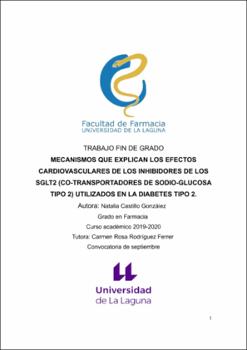Mecanismos que explican los efectos cardiovasculares de los inhibidores de los SGLT2 (Co-transportadores de sodio-glucosa tipo 2) utilizados en la diabetes tipo 2.c
Fecha
2020Resumen
Los inhibidores del co-transportador sodio-glucosa tipo 2 (iSGLT2) son un
grupo de antidiabéticos que han demostrado tener una serie de beneficios
cardiovasculares, por lo que han sido objeto de investigación. Los grandes
estudios que se centraron en éstos fármacos son EMPA-REG, CANVAS y
CVD-REAL, en los cuales se demostró no sólo la eficacia como antidiabéticos
sino que revelaron los beneficios cardiovasculares propios de este grupo
farmacológico. Durante los años en los que se realizaron dichos estudios, se
pudieron comprobar reducciones notables de los efectos cardiovasculares, en
la mortalidad por estos efectos y la hospitalización por insuficiencia cardíaca.
También se pudieron observar reducciones significativas en la presión arterial y
como se beneficia la energía del corazón diabético ante un cambio en el
sustrato.
Los mecanismos que hacen posible estos cambios a nivel cardiovascular van
desde la diuresis osmótica debida a la glucosuria a inhibiciones indirectas de
otros mecanismos de co-transportadores. Sin embargo, estos principios activos
no están exentos de reacciones adversas, las cuales discurren desde
infecciones del tracto genitourinario, hipoglucemia e incluso fracturas óseas
(muy poco frecuentes).
Los iSGLT2, como se puede observar, pueden ser una gran herramienta en el
tratamiento de la DM2, ya que los pacientes que la padecen tienen un mayor
riesgo de desarrollar enfermedades cardiovasculares. The sodium-glucose co-transportor type 2 inhibitors (iSGLT2) are a group of
antidiabetics that have been shown to have a number of cardiovascular benefits
and have therefore been the subject of research. The large studies that focused
on these drugs are EMPA-REG, CANVAS and CVD-REAL, in which it was
demostrated not only the effectiveness as antidiabetics but also revealed the
cardiovascular benefits of this pharmacological group. During the years in which
these studies were carried out, remarkable reductions in cardiovascular effects,
in mortality due to these effects and in hospitalization due to heart failure could
be verified. It was also possible to observe significant reductions in blood
pressure and how the energy of the diabetic heart benefits from a change in the
substrate.
The mechanisms that make these changes possible at the cardiovascular level
range from osmotic diuresis due to glycosuria to indirect inhibitions of other cocarrier mechanisms. However, these active ingredients are not exempt from
adverse reactions, which range from infections of the genitourinary tract,
hypoglycemia and even bone fractures (very rare).
The iSGLT2, as it can be observed, can be a great tool in the treatment of the
DM2, since the patients who suffer it have a greater risk of developing
cardiovascular diseases.





